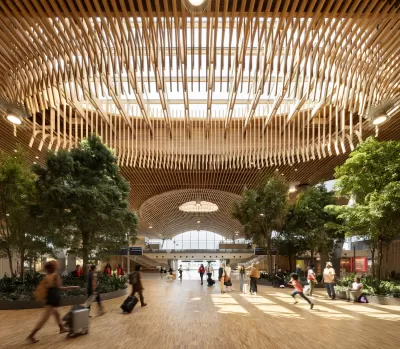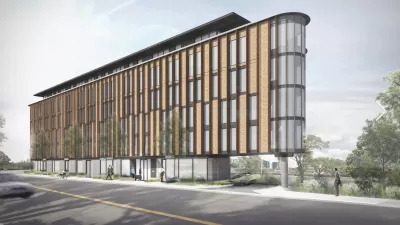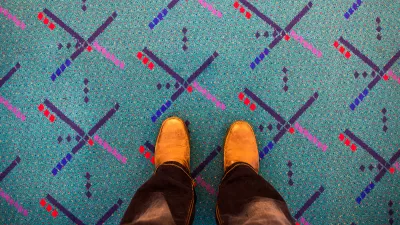Needing to expand to accommodate 35 million annual passengers by 2045 but constrained by Portland’s urban growth boundary, PDX had to think outside the box when planning its expansion. The result is a case study in sustainability.

The first phase of the nearly $2 billion expansion and renovation of Portland International Airport, commonly known as PDX, opened in August. It’s a novel project that has turned PDX into America’s largest mass-timber airport and, according to a recent article from Metropolis, represents a massive milestone for the mass-timber industry. It’s also an example of innovative, creative thinking to address a spate of challenges, including limited space for expansion because of the local urban growth boundary, lack of feasibility around building conjoining existing buildings, the need for seismic resilience against earthquakes, and the fact the existing terminal needed to stay operational during construction, and a desire for sustainability. The solution? Prefabricate a nine-acre wood roof at the edge of PDX’s grounds and slide it into place over top the existing, operational terminal.
“By choosing [a] rebuild over a new airport, the project reduced its carbon footprint by 70 percent, but this required complicated choreography,” Brian Libby, reports for Metropolis. The roof is made with 3.5 million board feet of Douglas Fir sourced from landowners and mills within a 300-mile radius of the airport. According to the article, “The just-completed first phase, built underneath [the timber roof], includes new check-in counters, a Market Hall lined with local businesses, enlarged security checkpoints, and a so-called ‘walk in the forest’: that includes 5,000 plants and 72 mature black walnut, ficus, and olive trees, courtesy of Portland landscape architecture studio PLACE. Phase 2, with passenger exit lanes, additional shopping-dining areas, and north-south views through walls of glass, opens in late 2025.”
FULL STORY: Forest to Frame: Why Portland’s Airport is a New Milestone for Mass Timber

Alabama: Trump Terminates Settlements for Black Communities Harmed By Raw Sewage
Trump deemed the landmark civil rights agreement “illegal DEI and environmental justice policy.”

Planetizen Federal Action Tracker
A weekly monitor of how Trump’s orders and actions are impacting planners and planning in America.

The 120 Year Old Tiny Home Villages That Sheltered San Francisco’s Earthquake Refugees
More than a century ago, San Francisco mobilized to house thousands of residents displaced by the 1906 earthquake. Could their strategy offer a model for the present?

LA’s Tree Emergency Goes Beyond Vandalism
After a vandal destroyed dozens of downtown LA trees, Mayor Karen Bass vowed to replace them. Days later, she slashed the city’s tree budget.

Sacramento Leads Nation With Bus-Mounted Bike Lane Enforcement Cameras
The city is the first to use its bus-mounted traffic enforcement system to cite drivers who park or drive in bike lanes.

Seattle Voters Approve Social Housing Referendum
Voters approved a corporate tax to fund the city’s housing authority despite an opposition campaign funded by Amazon and Microsoft.
Urban Design for Planners 1: Software Tools
This six-course series explores essential urban design concepts using open source software and equips planners with the tools they need to participate fully in the urban design process.
Planning for Universal Design
Learn the tools for implementing Universal Design in planning regulations.
Ada County Highway District
Clanton & Associates, Inc.
Jessamine County Fiscal Court
Institute for Housing and Urban Development Studies (IHS)
City of Grandview
Harvard GSD Executive Education
Toledo-Lucas County Plan Commissions
Salt Lake City
NYU Wagner Graduate School of Public Service





























